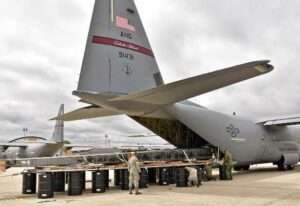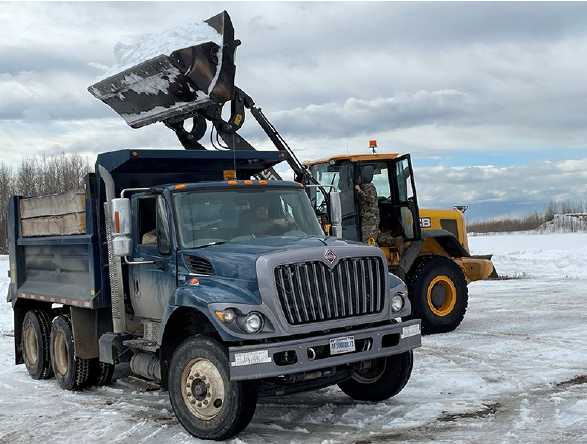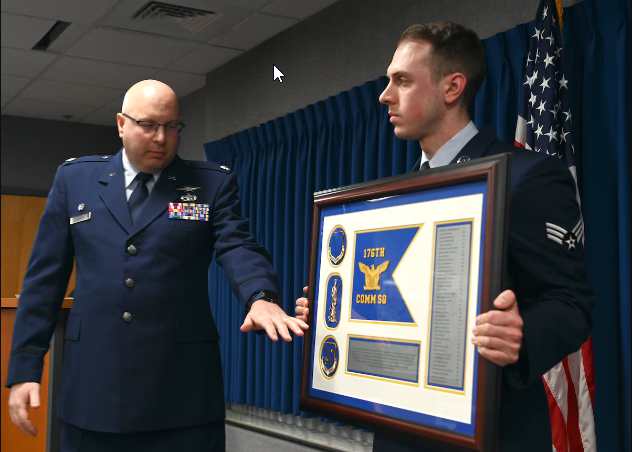
JOINT BASE ELMENDORF-RICHARDSON — A 176th Logistics Readiness Squadron Airman has been working through the 176th Wing Innovation team with the JBER Arctic Spark Innovation Lab to devise a method to rapidly offload equipment from cargo aircraft in an austere operating environment.
Senior Airman Juan Ortega, 176th LRS Air Transportation Function Flight, observed how the Air Force used heavy 55-gallon drums in what is called the Combat Offload Method B technique to download munitions on unimproved runways, and he envisioned the Rapid Yeti concept to lighten the load and expedite logistics operations.
Currently, the 176th Wing relies on high-reach K-loaders to load and unload munitions and supplies. This large material-handling vehicle loads and unloads ammunition and other heavy loads from aircraft, primarily the C-17 Globemaster III and the C-130 Hercules at JBER.
Recognizing the difficulty of transporting the K-loader equipment off-site, Ortega proposed the Logistic Operations Device (LOD) cart, a transportable and collapsible cart that mimics the non-destructive process of a combat offload in a modular, fast and safe manner.
The cart prototypes look like two metal shelves suspended on stilt-leg rollers. A smaller shelf stows underneath the larger cart for transport on two cargo pallet aircraft floor positions. Once assembled at a remote airfield, airlift loadmasters can roll cargo directly from the floor of the aircraft onto the cart in much the same manner they work with a K-loader.
Innovation and modernization play crucial roles in maintaining the readiness of the U.S. Air Force to counter adversarial threats. To further these objectives, the 176th Wing Air National Guard, the 3rd Wing and the 673rd Air Base Wing collaborated to establish the JBER Arctic Spark Innovative Lab at Joint Base Elmendorf-Richardson in 2019.
DoD personnel to include active, Guard, Reserve, civilian, and contractors are encouraged to submit ideas that can provide solutions to everyday challenges encountered in their jobs, providing a way to foster creation and implementation of solutions in the Air Force. Once an idea is submitted to the innovation lab, a roadmap is drawn to get from idea conception to production of a solution. That roadmap could include funding sources, policy changes, process improvements, production of product, prototype production, and training.
Ortega brought his idea to 176th LRS leadership who then encouraged him to submit it to Staff Sgt. Shawn McDermott, the 176th Wing’s director of Innovation at the Arctic Spark Lab. The idea was staffed within the lab for feasibility until it was determined funding was needed to see the project through. Next, the idea was published on the DoD’s National Security Innovation Network, an organization dedicated to building networks of innovators addressing national security problems.
Texas A&M took an interest in the idea, and their students created a model. After many prototypes, a near-final design has been adopted. The prototype is now open for testing at any willing Air Force Base in the United States. Air Force units across the U.S. are encouraged to volunteer to test and scale the final product.
In explaining the inspiration behind naming the project “Rapid Yeti,” Ortega said his role involves rapidly providing solutions, and the name reflects both the urgency of the task and the extreme arctic envioronment symbolized by the Yeti.
“Being able to ease the burden of Airmen downrange to make life a little bit easier is a win for me,” Ortega said. “Knowing I am doing something to help them while making things faster and more efficient fills me with a sense of pride and humility.”
[content id=”79272″]








